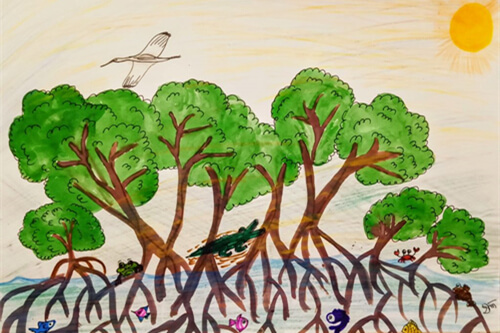
Message from Ms. Audrey Azoulay, Director-General of UNESCO, on the Occasion of the International Day for the Conservation of the Mangrove Ecosystem文章源自英文巴士-https://www.en84.com/11862.html
教科文组织总干事奥德蕾·阿祖莱保护红树林生态系统国际日致辞文章源自英文巴士-https://www.en84.com/11862.html
文章源自英文巴士-https://www.en84.com/11862.html
26 July 2021文章源自英文巴士-https://www.en84.com/11862.html
2021年7月26日文章源自英文巴士-https://www.en84.com/11862.html
文章源自英文巴士-https://www.en84.com/11862.html
In the plant world, mangroves are unique. Inhabiting a hostile environment, they have adapted to survive. Their roots stand in waterlogged ground, almost devoid of all oxygen. Their leaves and trunks are engineered to regulate salinity. To reproduce, they drop not seeds but seedlings – the plant equivalent of a live birth.文章源自英文巴士-https://www.en84.com/11862.html
文章源自英文巴士-https://www.en84.com/11862.html
红树林在植物界独一无二。它们生长在恶劣的环境中,为求得生存而努力适应环境。树根浸在水中,几乎得不到任何氧气。树叶和树干经过演化,变得可以调节含盐量。红树林的繁殖不是靠种子而是靠幼苗的脱落——这相当于植物界的“胎生”。文章源自英文巴士-https://www.en84.com/11862.html
文章源自英文巴士-https://www.en84.com/11862.html
However, mangroves are much more than marvels of nature. Standing in the intertidal zone between land and sea, mangroves perform a range of services for coastal communities in tropical and sub-tropical regions. They protect biodiversity by sheltering and nurturing marine life. They function like filtration systems, absorbing nutrients and pollutants. They fight coastal erosion, acting as breakwaters to dissipate storm surges and wave energy. Above all, they play an essential role as carbon sinks, sequestering atmospheric and oceanic carbon for long periods of time.
然而,红树林不仅是自然界的奇观。生长在陆地和海洋之间的潮间地带的红树林可以为热带和亚热带的沿海社区提供多种服务。红树林庇护和滋养着海洋生物,保护着生物多样性。它们就像是过滤系统,可以吸收营养物质和污染物。它们对抗海岸侵蚀,犹如筑起一道防波堤来消解风暴潮和波浪能。而最重要的是,红树林可以长期封存大气和海洋中的碳,发挥着碳汇的重要作用。
The health of humans has always depended on the health of the planet, but in today’s changing world, the importance of mangrove ecosystems is all too clear. Yet it is estimated that some countries lost more than 40% of their mangroves between 1980 and 2005, often due to coastal development. These plants currently cover a surface of just 14.8 million hectares – an area equivalent to the size of Greece.
人类的健康始终取决于地球的健康,在当今不断变化的世界中,红树林生态系统的重要性不言而喻。但据估计,由于沿海地区的开发,一些国家在1980年至2005年间丧失了40%以上的红树林。现存红树林面积仅为1480万公顷,相当于希腊国土面积。
The world is now waking up to the importance of mangroves – and other blue carbon ecosystems, including salt marshes, seagrass beds and coastal wetlands. UNESCO has long worked to conserve these essential areas in its World Heritage sites, Global Geoparks and Biosphere Reserves. The ecosystems in its marine World Heritage sites alone span 207 million hectares – 10% of all marine protected areas globally.
世界各国正在意识到红树林以及包括盐沼、海草床和沿海湿地在内的其他蓝碳生态系统的重要性。教科文组织长期以来致力于保护世界遗产地、世界地质公园和生物圈保护区中的这些重要区域。单是海洋世界遗产地中的生态系统就有2.07亿公顷,占全球海洋保护区总面积的10%。
When it comes to protecting ecosystems like these, UNESCO’s Biosphere Reserves offer a unique blueprint. In these areas, UNESCO is committed to implementing science-based solutions in coordination with local and indigenous communities, to support humanity’s ability to cope with socio-ecological change. In this way, we are protecting mangrove forests across the globe – from the Ranong Biosphere Reserve in Thailand, to the Delta du Saloum Biosphere Reserve in Senegal, via the Marawah Biosphere Reserve in the United Arab Emirates.
教科文组织生物圈保护区为保护此类生态系统提供了独特的样板。在这些区域,教科文组织与当地和土著社区协调,努力实施科学的解决方案,增强人类应对社会生态变化的能力。我们正在通过这种方式保护世界各地的红树林——从泰国的拉廊生物圈保护区,到塞内加尔的萨卢姆三角洲生物圈保护区,再到阿拉伯联合酋长国的马拉瓦生物圈保护区。
This year, the UNESCO World Network of Biosphere Reserves is celebrating its fiftieth anniversary – five decades of dialogue, knowledge sharing and poverty reduction, to rethink the relationship between people and nature. This year, we also celebrate the launch of the United Nations Decade of Ecosystem Restoration. Through these initiatives and others, we are working to protect mangroves and to better support scientific research into these environments.
今年是教科文组织世界生物圈保护区网络成立五十周年——回顾五十年来的对话、知识共享和减贫工作,重新思考人与自然之间的关系。今年,我们还欢庆“联合国生态系统恢复十年”的启动。通过以上举措和其他倡议,我们正在努力保护红树林,进一步支持对这些环境开展科学研究。
However, we cannot do this alone. We also need you – to participate in scientific research, monitoring, education and awareness; to contribute to conservation efforts. Please join us, so that, together, we can put a stop to mangrove habitat destruction, and restore what we have already lost.
然而,仅凭我们的力量还不够。我们需要大家参与科学研究、监测、教育和宣传,并为保护工作贡献力量。让我们携起手来,共同制止对红树林生境的破坏,并让丧失的红树林得以恢复。

